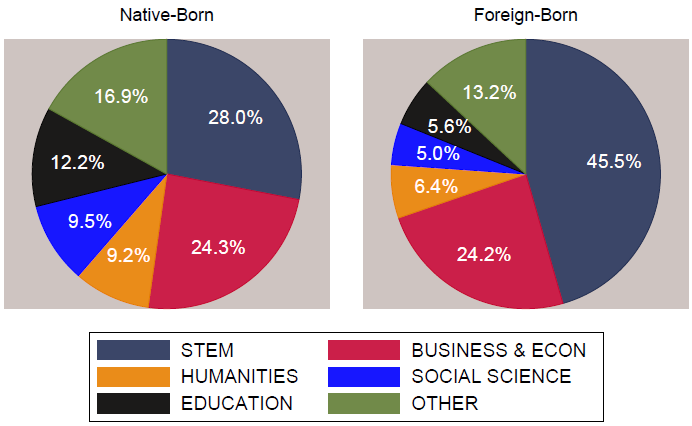Immigration to the US has risen tremendously in recent decades. Though media attention and popular discourse often focus on illegal immigrants or the high foreign-born presence among less-educated workers, the data show that immigrants are drawn from both ends of the education spectrum. At the low end, immigrants grew from 5% of workers with a high school degree or less in 1970 to 20.8% in 2010. At the high end, the figure rose from 7.3% to 18.2% for those with graduate degrees over the same period.1
These trends suggest that it is important for economists and policymakers to understand the effects of highly educated immigrant flows. The canonical economic model, based on demand and supply, holds that, all else equal, an increase in labour supply should cause wages to fall. Thus, immigration should depress wages paid to natives. Evidence for such a downward effect in academic work is mixed. For example, Borjas (2003, 2013) find a negative impact of immigration on wages, while Card (2009) and Ottaviano and Peri (2012) do not. For the canonical model to fail and for immigrants to generate wage gains for natives, it must be the case that all else is not equal in the case of immigration. This is because the labour market is more complex than the market for typical goods. Adjustment mechanisms exist to allow natives and firms to respond to immigration without experiencing lower wages or fewer employment opportunities. Immigrants may also generate positive externalities that benefit native workers. This article provides a brief summary of the recent evidence for these phenomena in the context of the market for workers with a college degree.
Immigrants to the US specialise in STEM
The first step in understanding the peculiarities of the labour market is to recognise that native and foreign labour differ in their underlying characteristics. We do not think that the popular refrain claiming that “the US faces a skills shortage” is a useful way to approach this issue. Rather, we recognise the existence of important differences between natives and immigrants. Figure 1 provides a sense of this by describing the college majors of US bachelor’s degree recipients. Compared to natives, foreign-born workers are disproportionately likely to have obtained a bachelor’s degree in Science, Technology, Engineering, or Mathematics (STEM). 45.5% of college-educated immigrants in the labour force have a STEM degree, whereas only 28% of natives do. Conversely, natives are twice as likely as immigrants to have majored in education (12.2% versus 5.6%) or social sciences (9.5% versus 5%).
Figure 1. Primary degree share by nativity – workers with a bachelor’s degree or more education, 2009–2012
Source: American Community Survey.
These differences are crucial to understanding how natives might respond to college-educated immigrant flows. Figure 1 indicates that immigrants possess a comparative advantage and specialise in STEM. Thus, we might expect that natives respond to inflows of STEM-dominant immigrants by specialising in non-STEM work. Indeed, Peri and Sparber (2011) provide evidence of this phenomenon – inflows of highly educated immigrants cause natives switch to more communication-intensive occupations.
The contribution of STEM to overall productivity
This comparative advantage and specialisation story is not unique to the market for college-educated labour. Peri and Sparber (2009) document similar behaviour among workers with a high school degree or less education. However, the fact that foreign college-educated immigrants tend to specialise in STEM has an additional implication of paramount importance. Economists have long recognised the significance of innovation in generating economic growth, and the role of scientists and engineers in fostering such knowledge production. The process of innovation generates positive spillovers for the economy as a whole. Thus, by increasing the country’s stock of knowledge, foreign-born STEM workers can increase the overall productivity of the economy.
A rather simplistic estimate of the contribution of foreign-born STEM to productivity in the US can be calculated from just two pieces of information. First, Jones (2002) estimates that 50% of US total factor productivity (TFP) growth in recent decades is attributable to scientists and engineers. Second, college-educated STEM workers grew from 2.9% of total employment in 1990 to 3.7% of employment in 2010, and foreign-born workers were responsible for 80% of this growth. By combining immigrants’ contributions to STEM growth with STEM’s contribution to TFP growth, we can deduce that roughly 40% of aggregate productivity growth may be due to foreign-born college-educated STEM workers.
This is an enormous figure and it is based on data at a very high level of aggregation. In Peri, Shih, and Sparber (2014), we assess whether more thorough economic analysis delivers comparable results. Using cross-city panel regressions to estimate wage and employment responses to foreign STEM, we find a rise in foreign STEM by one percentage point of total employment increases real wages of college-educated natives by 7–8 percentage points and those of non-college-educated natives by 3-4 percentage points. We find no statistically significant effects on native employment growth.
Instrumenting for the growth of foreign STEM workers
Causal identification is driven by three regularities. First, the presence of foreign STEM workers varied substantially across US cities in 1980. Second, the H-1B visa program – which has been the method of entry for highly skilled immigrants in the US since its inception in 1990 – produced national level changes in the number of skilled immigrants in the country that can be seen as exogenous from a city-level perspective. Third, new immigrants are attracted to locations where previous immigrant communities have already been established. By interacting 1980 city-level settlements with subsequent national-level policy, we can predict the number of new foreign STEM workers in each city. This H-1B-driven imputation of future foreign STEM workers is a good predictor of the actual increase in both foreign STEM and overall STEM workers in a city over subsequent decades. However it is not correlated, by construction, with the economic conditions in the city during the subsequent decades. It therefore makes an excellent instrument for the actual growth of foreign STEM workers to obtain causal estimates of the impact of STEM growth on the wages and employment of college and non-college-educated native-born workers.2
From the perspective of the canonical supply and demand model, the positive relationship between foreign labour supply and native wages may appear peculiar, but it is reasonable in the context of STEM-driven economic and productivity growth. The analysis in Peri, Shih, and Sparber (2014) uses an aggregate production model at the city level, to derive the productivity effect implied by the estimated wage and employment effects. We find that foreign STEM workers can explain 30% to 60% of US TFP growth between 1990 and 2010 – in line with the simple calculation cited above.
Discussion of results and policy implications
The large and positive wage and productivity effects from foreign-born STEM labour raise two important issues. The first concerns how, in the presence of these gains, studies sometimes find detrimental effects. Borjas (2013), for example, argues that immigration from 1990–2010 may have reduced wages paid to workers with a bachelor’s degree by 3.2%, and for workers with a graduate degree by 4.1%. Similarly, Borjas and Doran (2012) find that the post-1992 inflow of Soviet mathematicians pushed American mathematicians to lower quality institutions and reduced their academic productivity. To understand the conflict between these results and our own, it is important to recognise that our gains arise due to complementarities and positive externalities from innovation. Analyses that ignore occupational adjustment, understate complementarities across skill groups, fail to account for externalities, or analyse markets in which positive spillovers are small, are more likely to miss the gains associated with immigration.
The second is whether foreign STEM workers are truly needed since the US could presumably enact policies to produce its own STEM talent. This is true, but three qualifications are necessary. First, our analysis, as well as that of Kerr and Lincoln (2010), argues that foreign H-1B workers increase innovation and the productivity of US STEM workers without crowding them out. Thus it may be possible to increase both foreign and domestic STEM supply. Second, Hunt and Gauthier-Loiselle (2010) argue that immigrants are more entrepreneurial and innovative than natives, and this may add a further productive complementarity for natives. Third, native STEM development might require extensive and expensive investment, whereas immigration policy could be a more cost-effective way of building the country’s STEM workforce.
The comprehensive immigration reform proposed in the US Senate Bill 744 that would increase the annual number of H-1B visas allotted by 50,000 per year. In the light of the results above, it should be obvious that the provision would produce long-run positive effects on US wages and innovation.
References
Borjas, G J (2003), “The labor demand curve is downward sloping: reexamining the impact of immigration on the labor market”, Quarterly Journal of Economics, 118(4): 1335–1374.
Borjas, G J (2013), “Immigration and the American Worker: A Review of the Academic Literature”, Center for Immigration Studies, April.
Borjas, G J and K B Doran (2012), “The Collapse of the Soviet Union and the Productivity of American Mathematicians”, Quarterly Journal of Economics, 127(3): 1143–1203.
Card, D (2009), “Immigration and Inequality”, The American Economic Review, 99(2): 1–21.
Hunt, J and M Gauthier-Loiselle (2010), “How Much Does Immigration Boost Innovation?”, American Economic Journal: Macroeconomics: 31–56.
Jones, C I (2002), “Sources of US Economic Growth in a World of Ideas”, The American Economic Review, 92(1): 220–239.
Kerr, W R and W F Lincoln (2010), “The supply side of innovation: H-1B visa reforms and US ethnic invention”, Journal of Labor Economics, 28: 473–508.
Ottaviano, G I P and G Peri (2012), “Rethinking the Effect of Immigration on Wages”, Journal of the European Economic Association, 10(1): 152–197.
Peri, G and C Sparber (2009), “Task Specialization, Immigration, and Wages”, American Economic Journal: Applied Economics, 1(3): 135–169.
Peri, G and C Sparber (2011), “Highly-Educated Immigrants and Native Occupational Choice”, Industrial Relations, 50(3).
Peri, Giovanni, Kevin Shih, and Chad Sparber (2014), “Foreign STEM Workers and Native Wages and Employment in U.S. Cities“, NBER Working Papers 20093.
1 Summary statistics are based on Census and American Community Survey (ACS) data.
2 This methodology is not immune to criticism. Persistent city-specific shocks affecting immigration, employment, and wage growth, for example, would challenge the validity of our instrumental variable strategy. However, we perform a series of robustness checks that all point to the same result – foreign-born STEM workers increase wages paid to native-born workers, with larger effects for those with a college degree.






